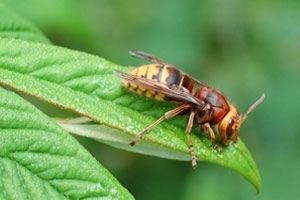Hornets
 Big, bold and brassy – but actually a bit of a pussy cat compared to their smaller cousins – that sums up Hornets compared to the more diminutive wasp family. They may appear to be pretty frightening with their loud, deep whirring flight and huge yellow and black bodies, but actually they are very rarely a nuisance, unlike wasps, which gather around our food and drink and seem to sting us with great regularity.
Big, bold and brassy – but actually a bit of a pussy cat compared to their smaller cousins – that sums up Hornets compared to the more diminutive wasp family. They may appear to be pretty frightening with their loud, deep whirring flight and huge yellow and black bodies, but actually they are very rarely a nuisance, unlike wasps, which gather around our food and drink and seem to sting us with great regularity.
The only time that you need to give hornets a wide birth is when you are in the vicinity of their nest site, which is usually sited in a hole in a tree or similar. They will defend their colony and dislike rapid movement and sudden loud noises around the nest, and will then be prepared to use the ultimate defence – the sting. I have been stung by a hornet and could not really say that it was any worse than a bee or wasp sting – they are all painful! Hornets will fly at night as well as by day and are attracted to light, occasionally resulting in one crashing around a bedroom light late at night, much to the consternation of the occupant!
The hornet's life cycle is similar to that of the common wasp. Newly mated queens hibernate during the winter, and emerge in spring to begin building a nest. They lay eggs that hatch into workers who take over nest-building and collecting food for the developing larvae. Later in the summer males and fertile females hatch and mating takes place, resulting in females that become next year’s queens. These mated females spend the autumn gathering nectar to sustain them over the winter months during hibernation in a hole or such like. The males, old queen and workers all die in the autumn.
The nest that hornets build is made out of wood pulp, gathered by the workers from rotten trees or by scraping wood fragments from fences or garden sheds. The collected wood is mixed with saliva to make it more soft and pliable and is then added to the nest. Once this moistened wood mix dries, it becomes a tough paper-like material and is often a range of different colours, depending on what type of wood was sourced to build the nest.
I hope I have convinced you that hornets are not really that scary, however if you happened to be another insect, then they must be pretty terrifying! They hunt down a wide range of insect prey to supply a constant demand for food back in the nest. I have watched them hunting through foliage like “flying tigers” seeking out their quarry, where they seem to purposely bump into plants, I imagine to dislodge or frighten insects into giving themselves away, because as soon as they are spotted, they are snatched and dispatched.
I watched a hornet take a painted lady butterfly last year, plucked off a buddleia bush where it had been feeding. Quite a struggle ensued, but slowly it managed to subdue the insect and then proceeded to remove the wings, one by one. The hornet then hung from a twig by just one leg while holding the prey with its other legs, where it then methodically bit off the butterfly’s legs, eventually flying off with just the main “meaty” body of the luckless beast! Not frightening to us, perhaps, but evidently a different proposition if you’re a fellow insect!
Peter Thompson
Advisory

Download Peter Thompson's essential 26-page book, featuring beautiful photography and detailed profiles of Britain's wildlife
Download FREE >